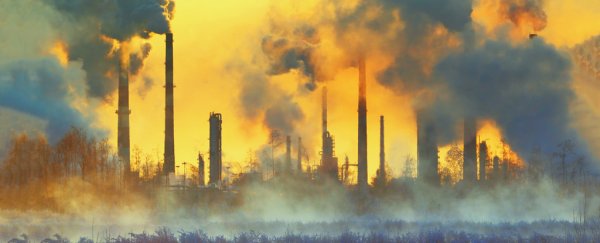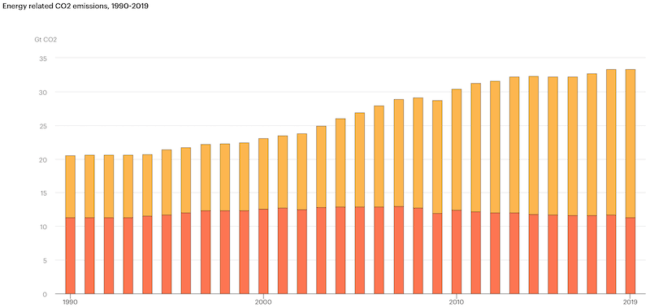
Each and every year our Fossil Fuel emissions have continued to relentlessly climb ever upwards. The existing expectation was that the numbers for 2019 would tell a similar story. That however just changed, the IEA (International Energy Agency), has published the numbers for 2019.
Global CO2 emissions flatlined in 2019.
Sanity Warning, don’t get too excited. There is some rather dire news concerning our Methane Emissions.
The Raw IEA Numbers for CO2
After two years of growth, global emissions were unchanged at 33 gigatonnes in 2019 even as the world economy expanded by 2.9%. This was primarily due to declining emissions from electricity generation in advanced economies. You can give thanks for this to the expanding role of renewable sources (mainly wind and solar). Fuel switching from coal to natural gas, and higher nuclear power generation also played a role.
But …
Other factors included milder weather in several countries, and slower economic growth in some emerging markets.
“We now need to work hard to make sure that 2019 is remembered as a definitive peak in global emissions, not just another pause in growth,” said Dr Fatih Birol, the IEA’s Executive Director. “We have the energy technologies to do this, and we have to make use of them all. The IEA is building a grand coalition focused on reducing emissions – encompassing governments, companies, investors and everyone with a genuine commitment to tackling our climate challenge.”

CO2 – The Good and the bad
A significant decrease within advanced economies in 2019 offset continued growth elsewhere.
US
The United States recorded the largest decline on a country basis, with a fall of 140 million tonnes, or 2.9%. That is now down by almost 1 gigatonne from the peak in 2000.
EU
Emissions in the European Union fell by 160 million tonnes, or 5%. This was driven by reductions in the power sector. Natural gas produced more electricity than coal for the first time ever. Meanwhile wind-powered electricity nearly caught up with coal-fired electricity.
Japan
Japan’s CO2 fell by 45 million tonnes, or around 4%. This is the fastest pace of decline since 2009, as output from recently restarted nuclear reactors increased.
Everybody else
CO2 in the rest of the world grew by close to 400 million tonnes in 2019. Almost 80% of the increase coming from countries in Asia where coal-fired power generation continued to rise.
Clean energy transitions are underway
Across advanced economies, emissions from the power sector declined to levels last seen in the late 1980s, when electricity demand was one-third lower than today. Coal-fired power generation in advanced economies declined by nearly 15%. This is a result of growth in renewables, coal-to-gas switching, a rise in nuclear power and weaker electricity demand.
“This welcome halt in emissions growth is grounds for optimism that we can tackle the climate challenge this decade,” said Dr Birol. “It is evidence that clean energy transitions are underway – and it’s also a signal that we have the opportunity to meaningfully move the needle on emissions through more ambitious policies and investments.”
Now the very bad News: Methane
A newly published study in Nature has revealed that methane emissions have been underestimated by up to 40%. Titled “Preindustrial CH4 indicates greater anthropogenic fossil CH4 emissions” and published on 19th February 2020, it reveals that atmospheric methane (CH4), a potent greenhouse gas, has more than doubled since the preindustrial era.
What exactly did this study do?
Here we use preindustrial-era ice core CH4 measurements to show that natural geological CH4 emissions to the atmosphere were about 1.6 teragrams CH4 per year, with a maximum of 5.4 teragrams CH4 per year (95 per cent confidence limit)—an order of magnitude lower than the currently used estimates. This result indicates that anthropogenic fossil CH4 emissions are underestimated by about 38 to 58 teragrams CH4 per year, or about 25 to 40 per cent of recent estimates
It might indeed sound dire, but this insight gives us a better understanding of the way forward. Tighter regulation of the fossil fuel industry and a greater shift towards renewables will not only impact CO2 emissions, but will also impact methane emissions as well.
Tighter regulation?
Today, it is common practise for many industrial plants to simply vent methane into the atmosphere.
Addressing this matters because methane accounts for about 20% of the total radiative forcing.
Subject Matter Expert Comments
Lead author of the study, Benjamin Hmiel …
“Placing stricter methane emission regulations on the fossil fuel industry will have the potential to reduce future global warming to a larger extent than previously thought,” Hmiel said. “Methane is important to study because if we make changes to our current methane emissions, it’s going to reflect more quickly.”
Dr Joeri Rogelj, a climate change lecturer at the Grantham Institute (not involved in the study) …
“This indicates that the fossil fuel sector has a much more polluting impact beyond being responsible for the overwhelming majority of carbon dioxide emissions. This is worrying and overall bad news,
What this study shows is that we can have a bigger impact on methane in the atmosphere than earlier thought. This allows us to set climate policy priorities right.”
Dave Reay, the executive director of the Edinburgh Centre for Carbon Innovation (not involved in the study) …
“We knew fossil fuel extraction – including fracking – was a major part of global methane emissions, but this impressive study suggests it is a far bigger culprit in human-induced climate change than we had ever thought,” he said.
“If correct, gas, coal and oil extraction and distribution around the world are responsible for almost half of all human-induced methane emissions. Add to that all the carbon dioxide that is then emitted when the fossil fuels are burned, and you need look no further for the seat of the climate emergency fire.”
Emissions – Further Reading
CO2 …
- Wikipedia Page on the International Energy Agency
- The IEA homepage
- IEA Report (Published Feb 2020) – Global CO2 emissions in 2019
Methane …
- Nature (19-Feb-2020) – Preindustrial 14CH4 indicates greater anthropogenic fossil CH4 emissions
- Guardian – Oil and gas firms ‘have had far worse climate impact than thought’
